SDG 07: Affordable and Clean Energy

This Learning World focuses on understanding the importance of sustainable and affordable energy for everyone, everywhere. The Learning World provides ideas and components that you can integrate into your teaching: An interactive boardstory with complementary exercises, a glossary with the most important terms of the Learning World, additional exercises to consolidate and further reflect on the contents of SDG 7 as well as examples of the connections between this SDG and others.
Boardstory for interactive learning
Educational Material
The Learning Objectives outline the key competencies students will develop by completing this Learning World. They also highlight connections to other topics, encouraging further exploration and discussion beyond this module.
Learning Objectives
Acquiring competencies for sustainable development is part of a lifelong learning process. The boardstory and exercises provided in this learning world initiate this process and help students gain knowledge, reflect and think critically, and take meaningful action. After completing this unit, it is recommended to foster the development of the desired competencies for sustainable development e.g. by teaching further learning worlds. Thus, expanding students’ skill sets further.
With this in mind, the learning objectives of this specific learning world first and foremost aim to develop a basic understanding of the respective SDG and related connections for students aged nine to eleven. Gaining and expanding competencies for sustainable development further is desirable, but can only be achieved through continuous immersion and persistence.
Following the interaction with this Learning World, the students will be able to:
discuss different energy resources – renewable and non-renewable – and explain respective (dis-)advantages including environmental impacts, health issues, usage, safety and energy security.
explain the need for affordable, reliable, sustainable and clean energy transnational and for all people.
explain the concepts of energy efficiency and sufficiency as well as their importance.
discuss how different regions have access to different energy sources, e.g. due to geographic location and features, and that these sources need to be adapted to the specific context of the regions.
recognize the need for new and innovative technologies and collaborations between countries.
recognize that policies can influence the development of energy production, supply, demand and usage of energy, e.g. by setting restrictions, creating benefits and obstacles as well as providing guidelines.
evaluate their own energy usage in terms of efficiency and sufficiency and make changes within their personal range of action (e.g. talking to their caregivers, too).
compare the share of different energy sources in their own local and national as well as the global energy mix.
argue for affordable, reliable, sustainable and clean energy for all.
Connection to other SDGs
The 17 SDGs complement each other and should not be viewed in isolation. As such synergy effects can occur, for example an improvement in one of the SDGs can in turn have a positive effect on another. At the same time, prioritizing measures for one SDG can also lead to another goal being neglected. The following overview provides examples of connections between SDGs which can be used to open up new conversations and linking points to take the topic beyond this learning world.
Learning World
SDG 01: No Poverty
Learning World
SDG 03: Good Health and Well-being
Learning World
SDG 04: Quality Education
Learning World
SDG 06: Clean Water and Sanitation
Learning World
SDG 08: Decent Work and Economic Growth
Learning World
SDG 09: Industry, Innovation and Infrastructure
Learning World
SDG 10: Reduced Inequalities
Learning World
SDG 11: Sustainable Cities and Communities
Learning World
SDG 12: Responsible Consumption and Production
Learning World
SDG 13: Climate Action
Learning World
SDG 14: Life below Water
Learning World
SDG 15: Life on Land
Learning World
SDG 16: Peace, Justice and Strong Institutions
Learning World
SDG 17: Partnerships for the Goals
Learning World
SDG Dilemmas
Learning World
SDG Wedding Cake Model
















 Before watching the boardstory for the first time, give the students a listening task: "What do you learn in the boardstory?" Possibly with the addition: "Remember at least three things."
Before watching the boardstory for the first time, give the students a listening task: "What do you learn in the boardstory?" Possibly with the addition: "Remember at least three things." Hand out the worksheets "EXPLORING THE BOARDSTORY" from the student workbook to engage the students in the content of the SDG 7 Boardstory.
Hand out the worksheets "EXPLORING THE BOARDSTORY" from the student workbook to engage the students in the content of the SDG 7 Boardstory. The Memory Game is a good basis to be equipped with knowledge to play the following exercise “ENERGY SOURCES TABOO” game, and supports a more visual based type of learning.
The Memory Game is a good basis to be equipped with knowledge to play the following exercise “ENERGY SOURCES TABOO” game, and supports a more visual based type of learning. First, prepare the memory cards by printing the respective worksheets “MEMORY ON ENERGY PRODUCTION AND IMPACT” of the student workbook (30 pairs). Cut out the cards. Form teams of approx. 3-4 students that play a game of memory trying to find the pairs. Each pair has the same picture and is connected by one matching fact. There is one difficulty: Two pairs have the same image, but their matching fact differs.
First, prepare the memory cards by printing the respective worksheets “MEMORY ON ENERGY PRODUCTION AND IMPACT” of the student workbook (30 pairs). Cut out the cards. Form teams of approx. 3-4 students that play a game of memory trying to find the pairs. Each pair has the same picture and is connected by one matching fact. There is one difficulty: Two pairs have the same image, but their matching fact differs.

